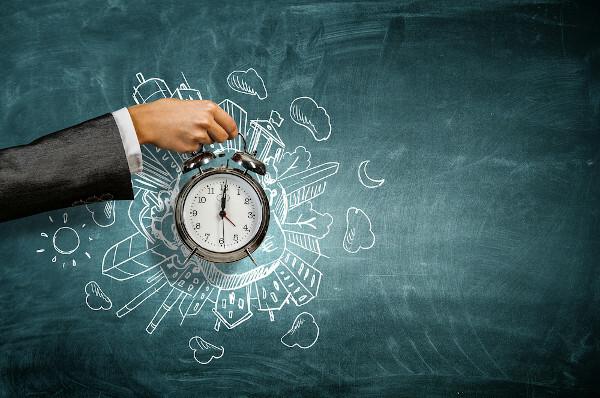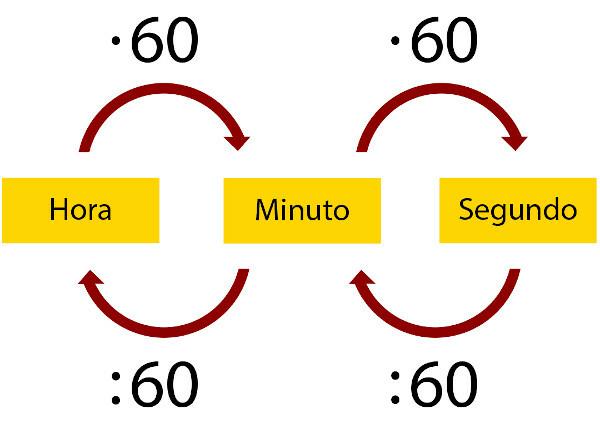At time measures were invented, throughout history, due to the needs of the civilizations of control the days and hours, which helped decision-making at the time, such as the best month for cultivation, measuring river floods, among other things. Today they are still essential, as a society that does not measure time has become unimaginable.
They exist various instruments we use to measure this greatness: we control the days in relation to the year based on the calendar, we control the hours, minutes and seconds based on the clock, and to measure the variation of shorter times we use stopwatches.
Read too: What are the length measurements?
Units of Measures of Time

There are several units of time measurement (which will be shown throughout the text), such as days, you years old and the months, but we use the hours. Based on hours, we have its sub-multiples, which are minutes and seconds.
It is important to understand that an hour is made up of 60 minutes and that each minute is made up of 60 seconds. On the other hand, working with longer time intervals, we have that a day has 24 hours, and based on in the day, various units of time measures appear, such as weeks, months, years, and so on. successively.
Conversion of the unit of measure of time
To perform the conversion of the unit of measure of time, from hours to minutes or from minutes to seconds, we perform the multiplication by 60, because we know that an hour has 60 minutes and that a minute has 60 seconds. As a result, when the conversion is in the opposite direction, that is, from seconds to minutes and from minutes to hours, we perform the division by 60. See the following diagram that can help you visualize these conversions:

Note that to transform from hours to seconds, we first transform in minutes and then transform in seconds, that is, we multiply by 60 and then by 60 again, which is the same as multiply for 3600. The opposite operation, that is, from second to hour, becomes a division by 3600.
Example:
How many seconds are there in two hours and 15 minutes?
To do this, we will first carry out the conversion of two hours into minutes:
2 · 60 = 120 minutes
So, with 15 minutes, we have 120 + 15 = 135 minutes. Now let's convert 135 minutes to seconds:
135 · 60 = 8100 seconds
See too: What are mass measurements?
Time measurement instruments
The first way to measure time was by analyzing the position of shello about TmissTherefore, the known today as sundials were created, used to measure the hours during the day. Today we use the clock battery powered for this function. Other instruments emerged, such as the hourglasses and the timer, that serve to measure shorter time spans.
Throughout history, several calendars, which are used to measure days and months in relation to the year. Ancient peoples made different calendars and divided the years differently. Today the most common is the Gregorian calendar, used in most countries. It is noteworthy that both days and years take into account the position of the stars in relation to the Earth, and, therefore, there has been great interest in astrology since the most ancient peoples.

other time units
We know of other units of time measures that arise through the aforementioned units, such as bimester, semester, century, decade, fortnight. The table below contains the time units present in everyday life.
Unit |
Equals |
1 second | |
1 minute |
60 seconds |
1 hour |
60 minutes |
1 day |
24 hours |
1 week |
7 days |
1 fortnight |
15 days |
1 month |
28 or 29 days (February) 30 or 31 days (other months) |
First quarter |
2 months |
1 trimester |
3 months |
1 quarter |
Four months |
1 semester |
6 months |
1 year |
12 months or 365 days |
1 biennium |
2 years |
1 triennium |
3 years |
1 quadrennium |
4 years |
1 quinquennium |
5 years |
1 of each |
10 years |
1 century |
100 years |
1 millennium |
1000 years |
solved exercises
Question 1 - We know that, currently, one of the villains for high electricity costs and water waste is electric showers, if they are not used conscientiously. Suppose that, in Isadora's house, the shower has a flow rate of 18 liters per minute, if, at the end of a week, she used about 4860 liters, how long was she in the bath during that week?
A) four and a half hours
B) four hours
C) three and a half hours
D) three hours
E) five hours
Resolution
Alternative A
First, we will divide the amount of water used in the week by the shower flow, to find out the time in minutes spent by Isadora:
4860: 18 = 270
However, the alternatives are in hours, and we know that 270: 60 = 4.5, which is equivalent to four and a half hours.
Question 2 - How many seconds are two hours and 30 minutes?
A) 8000
B) 150
C) 15,000
D) 900
E) 9000
Resolution
Alternative E
We know that an hour is 60 minutes, so two hours have 2 · 60 = 120 minutes.
As it is two hours and 30 minutes, we have a total of 150 minutes. Each minute has 60 seconds, so we will do 150 · 60 = 9000 seconds.
By Raul Rodrigues de Oliveira
Maths teacher
Source: Brazil School - https://brasilescola.uol.com.br/matematica/o-controle-tempo-suas-unidades-medida.htm
